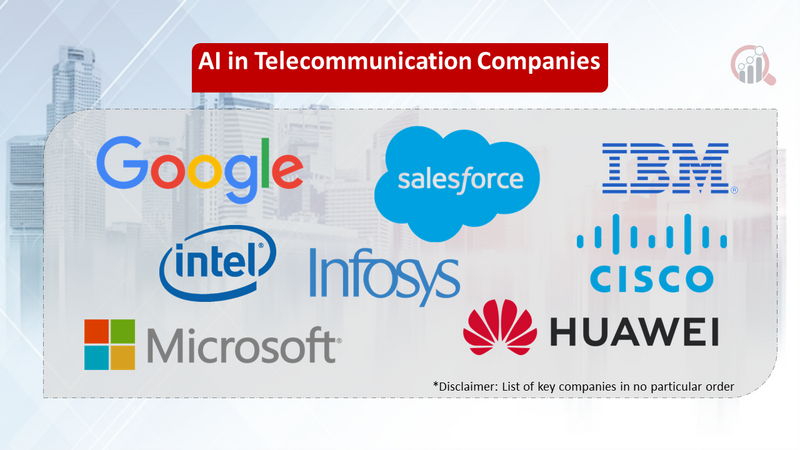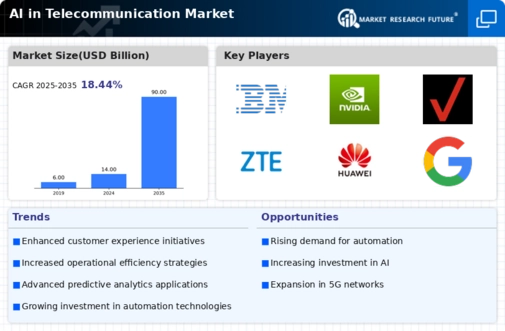Top Industry Leaders in the AI in Telecommunication Market

Competitive Landscape of AI in Telecommunications: A Bird's-Eye View
The AI in telecommunications industry stands at the precipice of a paradigm shift, fueled by the burgeoning force of artificial intelligence (AI). From optimizing network performance to personalizing customer experiences, AI promises to revolutionize every facet of telecom operations. This burgeoning landscape is attracting a diverse range of players, each vying for a slice of the pie.
Key Players:
-
Huawei Technologies Co. Ltd (China)
-
IBM Corporation (US)
-
Microsoft Corporation (US)
-
Intel Corporation (US)
-
Cisco Systems (US)
-
Nuance Communication (US)
-
ZTE Corporation (China)
-
ai (US)
-
Salesforce (US)
-
Infosys Limited (India)
-
Google LLC (US)., among others
Factors for Market Share Analysis:
-
Technology Breadth and Depth: Players with diverse AI portfolios and expertise across various applications hold an advantage. Companies offering end-to-end solutions from network optimization to customer engagement will attract broader adoption.
-
Regional Focus and Partnerships: Understanding and catering to specific regional needs and building strong partnerships with local telecom operators are crucial for success. Companies with established regional footprints and collaborative alliances will have a head start.
-
Data & Cloud Infrastructure: Access to vast data sets and robust cloud infrastructure is essential for training and deploying effective AI models. Players with strong cloud partnerships or proprietary data infrastructure will have a competitive edge.
-
Innovation and Agility: The AI landscape is dynamic, and continuous innovation is key to staying ahead. Companies with a strong commitment to R&D and a culture of agile development will be better equipped to adapt to evolving market demands.
New and Emerging Companies:
-
Edge Computing Providers: Companies like Fastly and Cloudflare are bringing AI capabilities closer to the network edge, enabling real-time decision-making and faster response times. This technology holds immense potential for network optimization and latency reduction.
-
Cybersecurity Specialists: With rising security threats, AI-powered cybersecurity solutions are in high demand. Companies like Deepwatch and Darktrace are developing AI-driven anomaly detection and threat prevention solutions specifically for telecom networks.
-
Vertical-Specific Providers: Companies like Airr and Sentient Networks are specializing in AI solutions for specific telecom sub-sectors. Airr focuses on AI-powered optimization for mobile networks, while Sentient Networks leverages AI for predictive maintenance in satellite communication systems.
Current Investment Trends:
-
Cloud-Based AI Solutions: As telecom operators migrate to cloud-based infrastructure, demand for cloud-native AI solutions that seamlessly integrate with cloud platforms is booming.
-
Open RAN Adoption: The shift towards open radio access networks (RAN) creates opportunities for startups with innovative AI-powered network management solutions compatible with open ecosystems.
-
Personalization and Customer Experience: Investments are pouring into AI-powered personalized customer experiences, including proactive service recommendations, chatbots, and virtual assistants.
Latest Company Updates:
-
January 4, 2024: Vodafone launches virtual assistant for enterprise customers: Vodafone introduced an AI-powered virtual assistant specifically designed for enterprise customers. The assistant can handle a range of tasks, including troubleshooting technical issues, answering billing inquiries, and scheduling appointments.
-
December 21, 2023: Ericsson partners with AI startup Cohere for network optimization: Ericsson announced a partnership with AI startup Cohere to utilize the latter's generative language models for network optimization and automation. This collaboration aims to improve network efficiency, reduce energy consumption, and enhance user experience.
-
November 29, 2023: AT&T deploys AI-powered fraud detection system: AT&T announced the successful implementation of an AI-powered fraud detection system that has significantly reduced fraudulent activity on its network. The system uses machine learning algorithms to analyze network traffic patterns and identify anomalies indicative of fraudulent activity.

